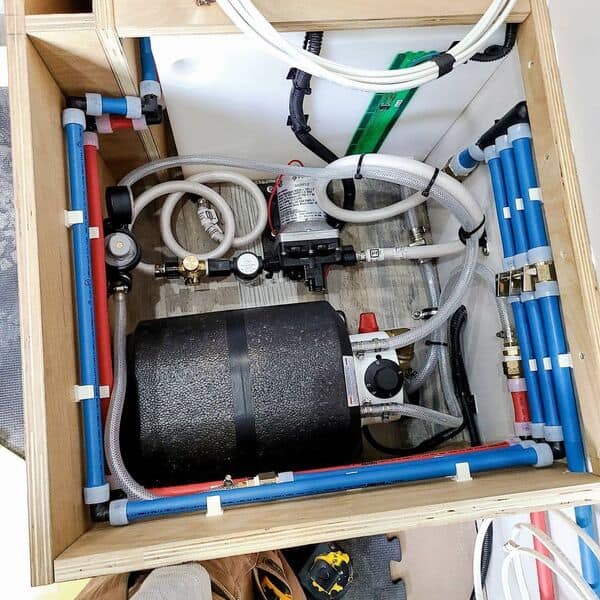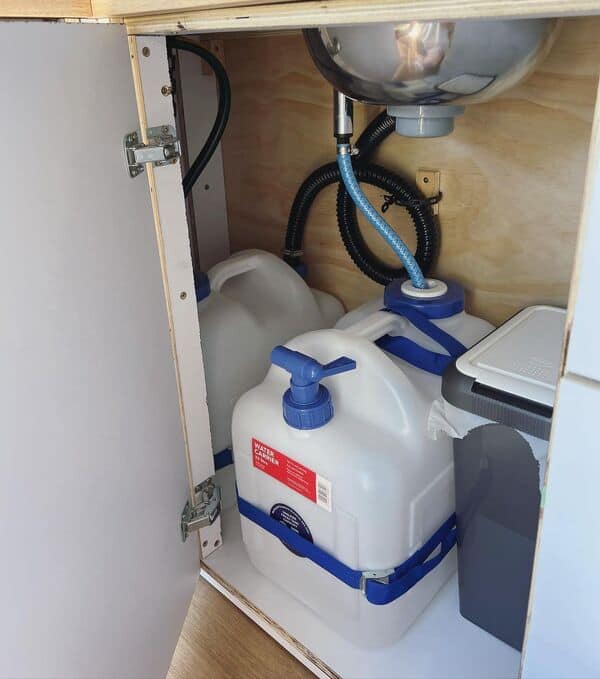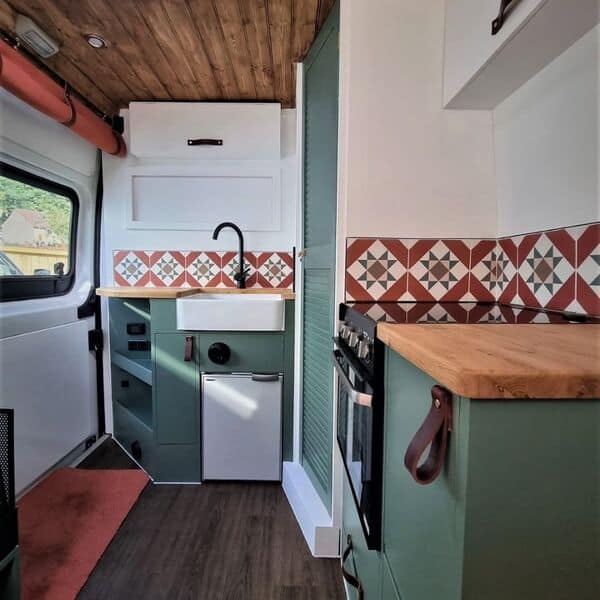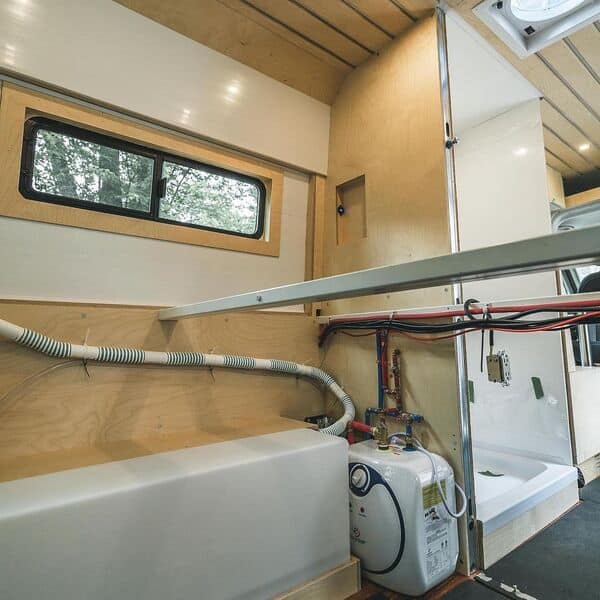You need a water storage solution and a water supply in your van regardless of the travel you take. Options range from simple 7-gallon containers to plumbing with pumps, storage tanks, sinks, showers, etc. Having a convenient solution to fulfill your requirements make your van life a much more pleasant experience.
Each solution has its pros and cons. But everything depends on the budget you have. I will give you a summary of widely available solutions to help make your decision.

Table of Contents
Plumbing planning stage
The carrying water capacity determines based on your usage and needs. You need more water if there is a shower or if you plan to have extended boondocking.
The placement of the storage tanks depends on whether you need a three-season or a four-season van.
The biggest challenge is deciding on an energy source for the heating water if you plan to have hot water.
The next challenging task is to figure out the suitable sink dimensions. A large deep sink makes it easier to do your dishes.
PEX tubes are one of the popular choices for van plumbing. Different fitting types are available, and some fittings need special tools to connect the fitting with the tube.
So here are some options to consider for the above problems that you might come across.
Tanks options
One gallon of water weighs roughly 8.33 lbs. So the weight of the onboard water affects the Gross Vehicle Weight Rating (GVWR) of the van. Typically van lifers have between 10 to 50 gallons of fresh water capacity tanks.
The simplest tank option for fresh and grey water is using 7-gallon drinking water containers. These 7-gallon tanks are a popular choice for grey water storage, and you can easily place them under the sink.
Use a two-way valve to drain excess greywater directly to the ground through a ¾ inch pipe. This method will prevent any spillover on the van floor due to overflow, and you don’t need to go out to dump water at night.

Make sure to use biodegradable toiletries and detergents if you are dumping greywater directly to the ground.
High-Density Poly Ethylene (HDPE) tanks are the other option for a larger holding capacity. HDPE tanks can use hold fresh, grey, and black waters. These tanks can install inside or underneath the van.
There are tanks specially designed to use the wasted space around the wheel well and mounts in the factory rear spare tire basket.
Placing tanks externally is challenging if you plan to travel in freezing temperatures. Water expands when it freezes, which may cause the tanks and other plumbing components to burst.
There are a couple of ways to address this freezing issue and save your setup.
- Drain all water and fill with antifreeze.
- Heat tanks using electric heater pads.
- Heat tanks using hydronic heating.
Each above solution has its pros and cons. Some are not like to use antifreeze due to the chemical usage, and there should be a way to fulfill the water requirements through some other means during the winter.
Heater pads consume electricity, and you need a bigger battery capacity to support the demand.
Hydronic heating systems are a bit expensive. But it can work as a heat source for heating the water, air, and floor if you decide to include one in the van build.
Plumbing tubes
PEX tubes use almost all the latest van builds to lay freshwater lines. PEX is easy to work with and durable.
One of the best properties of PEX is that it can adjust for freezing. PEX has a small margin of expansion due to its flexibility, and this ability prevents pipes from getting an eruption. But make sure not to expose pipes to freezing conditions with water.
PEX tubes are rates 100 psi at 180°F and 80 psi at 200°F.
The presence of hot chlorinated water can cause PEX pipe to degrade, causing pinhole leaks and pipe failures. Chlorine damage is a long-term effect like 10 – 12 years, but there is a danger. PEX is not UV resistant and should not expose to the sun for a prolonged period.
PEX tubes come as PEX-A, PEX-B, and PEX-C to state their manufacturing method.
PEX-A is the most flexible tube and has a lower chlorine resistance and lower burst pressures. Typical water pumps used in van builds can’t generate high pressure, leading to burst pipes.
PEX-B has the highest chorine resistance and burst pressures but loses flexibility compared to PEX-A.
Flexible tubes are ideal for greywater plumbing. Typically ½ inch tubes are used for the sink and 1 ½ inch for the shower drain. But I also recommend using ¾ to 1 inch drain tubes for the sink.
Make sure to add a p-trap to your greywater drain to prevent sewer gas come through tubes. HepVo waterless valve is a good alternative for traditional p-trap.
PEX Fittings and Connections
There are few PEX connections available as compression, expansion, crimp, clamp, press, and push-to-connect. Popular choices for van build are crimp, clamp, expansion, and push connect types.
Push connect type connections don’t need any tool to configure and are pretty easy to work. These fittings are the priciest among all connection types. SharkBite, GatorBite are some popular brands.
Both crimp and clamp work with crimp-type fittings. You need either a crimp or cinch tool to make the connection. Both crimp and clamp fittings are cheap comparably to other types. The clamp connection is the easiest to work with among these two types.
The expansion system works with expansion rings and ProPEX expansion fittings. You need an expander tool to make the expansion. The expansion fittings type only works with PEX-A tubing.
Fittings materials make from either brass or poly (Polyphenylsulfone).
Water pump
Hand or Foot pump
Manual pumps are suitable for water conservation. Mainly your water storage is based on containers, and then this is the way to use it. It may take some time to fill a large pot, but that will be a good exercise for you.
Cheap pumps are quite often starting to leak after some time. So make sure to do thorough research before selecting a brand.
Electric pump
12V diaphragm electric water pumps are mainly used for van builds. The pump automatically starts once it detects a pressure drop, so you don’t need to switch on additionally to use it. But make sure to add a switch to power on/off.
The water pump can draw up to 7.5 amps. Water pressure can reduce if filters are between the pump and faucets/shower. So consider that when purchasing a pump.
Make sure to use an accumulator along with the pressure pump. Accumulators help to increase pump life and save battery power by reducing unwanted cycles and pulsation.
Sink
You need a sink whether you have a running water system or not. A large wooden salad bowl is an option if the budget is tight. Selecting a square/rectangle sink over a round bowl shape is more suitable for reducing wasted space.
You can build a farmhouse sink using a small bathroom sink like this. Fix it sideways to get the most benefit out of that space.
Make sure to select a sink with a suitable depth. You will not regret that decision.

Shower
There are fewer things to concern if you opt for an outdoor shower. You don’t need to worry about plumbing at all. You either need to pick a unit that provides hot water flow or some portable shower units that work with a hot water container.
It is convenient that have an indoor shower. But again it all depends on your requirements. Make sure to use a low-flow showerhead, especially if you have an indoor shower.
A recirculating shower is also an option if that suits you. A recirculating shower system comes in handy if you plan to do an extended boondocking.
Hot water
You need a way to source hot water if you plan to shower indoors or outdoors. The easiest outdoor shower option is to use a portable solar shower bag. You hang the water-filled shower bag until it is warm and take a shower.
Another option is to use a rechargeable portable camp shower pump. You need to source the hot water separately.
A tankless propane water heater is a popular choice. It gives an instant hot water supply without maintaining a water tank and without waiting for water to get heat. Carrying propane is a safety concern if not following proper guidelines. Opt for 1lb refillable cylinders instead of a large tank that can handle safely and securely. But it may cost you some extra penny.

Tank water heaters need if you plan to have an indoor shower. The problem with this type of water heater is the power consumption. 110v heaters consume less energy than 12v heaters, but they require power via an inverter. A 110v heater heats water much faster than a 12v heater.
Most of the time, solar panels produce excess electricity on a clear sky day. Some van builds have second alternators to charge the battery system while on the move. This extra electricity can use to heat the water through a 12v heater. This kind of work may need some DIY tasks but remove a lot of burden from your battery system as you may not need it regularly.
Hydronic heating systems are another way to get hot water for your campervan. Heat exchangers in these systems can configure with a fuel burner to produce heated coolant. Then exchange the heat of that coolant with the water in a copper plate heat exchanger.
Some water heaters have built-in heat exchange capabilities to plug an external liquid heat source to heat the water.
Here are some more plumbing tips to avoid mistakes
- Use a suitable pipe thread sealant to connect fittings instead of Teflon tapes.
- Insulate tubes with foam pipe insulation where they touch walls or cabinets to reduce the vibration noise.
- Sediment can enter the water pump and cause problems. Use a filter before the pump’s water inlet to prevent that.
- Some water heaters produce scalding water. Install a thermostatic mixing valve as a safety precaution. It takes the hot and cold water and mixes it to a set point of your choice. So there will be no accidental scalding while using the shower or sink.
- Use an accumulator with the water pump. Accumulators help to increase pump life and save battery power by reducing unwanted cycles and pulsation.
